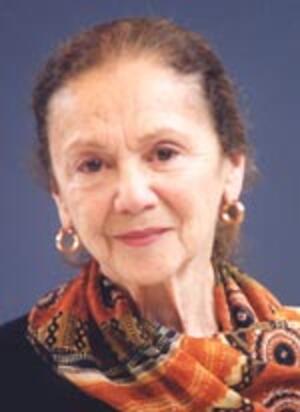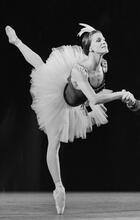Irina Jacobson
Irina Jacobson, a Soviet-Russian dancer and teacher, was the living index to the remarkable archive of radical ballets for the Kirov and Bolshoi Ballets made by her husband, Leonid Jacobson, the only Jewish choreographer during the Stalinist period. A former soloist with the Kirov Ballet, Irina Jacobson was the last protégée of the legendary ballet teacher Agrippina Vaganova. After the death of her husband, Jacobson emigrated to the West, where she was in demand as a teacher and also staged her husband’s ballets in leading troupes internationally. Among these was his dangerous and infamous Jewish Wedding, a portrait of Jewish suffering set as a shtetl wedding, which had enraged Soviet authorities and censors.
Irina Jacobson was a Soviet-Russian dancer, teacher, and international authority on the staging of the major nineteenth- and twentieth-century Romantic and Classical ballets. She also directed Choreographic Miniatures, the St. Petersburg ballet company of her late husband, Leonid Jacobson, the leading iconoclastic Soviet ballet choreographer. A former soloist with the Kirov Ballet, Irina Jacobson was the last protégée of Agrippina Vaganova, the influential teacher at the State Academic Theatre for Opera and Ballet (GATOB, later the Kirov) who systematized the teaching of ballet for the new era of Soviet ballet and who recognized and inspired Irina Jacobson’s gifts as an exacting and inspired ballet pedagogue.
Early Years
Irina (Pevzner) Jacobson was born May 31, 1924, in Leningrad (St. Petersburg) Russia, to Dveira Leya (later Yelizaveta) Gurevitch Pevzner, a 24-year-old bookkeeper from Gomel in Belorussia province, and David Pevzner, a 27-year-old civil engineer from Mogilev, Belorussia. The Pevzners had one other child, Anna Pevzner Klimentenko, born in 1922. Jacobson’s father came from a highly educated family and each of his three brothers and two sisters graduated from a university either in Russia or Germany. He met Jacobson’s mother while a member of the Russian cavalry stationed in Belorussia; after a three-day courtship, she returned with him to St. Petersburg. They were well educated Jews—Yelizaveta had a college education in economics—and after they married in 1919, they returned to Pevzner’s home in St. Petersburg. During the Stalinist purges David Pevzner was exiled to prison in Siberia from 1929 to 1932, an ordeal from which he returned, while several of his relatives did not.
In school in St. Petersburg as an eight-year-old, Irina became a pioneer, the first step toward training for membership in the Communist Party, but she left at the age of twelve and steadfastly refused any further association with either the Komsomol (young Communist league) or the Communist Party, despite continual pressures to join. When they first arrived in St. Petersburg, the Pevzners rented a four-room apartment, but over time the government moved others into the apartment, until only two rooms remained for the four Pevzners. A famous older ballet critic, Alexander Clayman, moved into one of the Pevzner’s former rooms and became friendly with the family. When David Pevzner was sent into exile, Clayman suggested to Yelizaveta Pevzner that she audition her daughters for the Theater Academy on Theatre Street where, if accepted, the girls could get broadly educated not only in ballet, but also in music and the arts. In 1933 at the age of nine, Irina and her sister Anna auditioned, together with several hundred others, and were among the twenty accepted that year into the beginning class of the Leningrad Choreographic School (since renamed Vaganova Academy). Since she was already in the second class of regular school, Irina had to repeat her first year, but since Anna was two years ahead Yelizaveta did not enroll her in the ballet academy, deciding she would be too old when she finished.
Entering Professional Life
therefore engaged a private tutor, Capitalina Arhipova, who worked with her individually; at the end of five years she was the best in her class. Irina made her debut with the Kirov Ballet at the age of fourteen, dancing as attendant to the princess in The Sleeping Beauty. Then the war came. In 1941, as the German Army advanced on Leningrad, Irina and her partner from the Choreographic School were assigned with an itinerant group of performers to entertain the Russian army at encampments throughout the Baltic. In August, while on the way to a performance in Estonia, the dancers’ bus was engulfed and almost overtaken by soldiers fleeing the advancing Germans. Miraculously the driver succeeded in returning the dancers to Leningrad and the following day, on August 18,1941, Irina and her family were just in time to be evacuated in freight cars with the entire Kirov Ballet and School to Perm, where they were given a single room for the five of them. For the next three years, until the Kirov returned to Leningrad in 1944, this was their home.
In Perm, ballet classes continued in a converted garage that was so cold that when water was sprinkled on the wooden floor during class it immediately froze into a slippery layer of ice as the dancers took class and rehearsed. In late 1943 Irina danced her graduation performance as the top student in her class, performing a Hungarian dance and the entire grand pas from the last act of Raymonda, as well as the lead in Makovets’s The Magic Flute. Vaganova favored Irina for her musicality and keen analytic intelligence and asked her to teach her class when she became too ill to teach in the late 1940s. It was from observing Vaganova that Irina said she learned how to train bodies for strength and yet with a softness in the arms and feet.
Meeting Leonid Jacobson
In 1944 Irina joined the Kirov Ballet as a corps de ballet member, retiring as a soloist in 1964. The same year that she joined the Kirov, Irina met the brilliant choreographer Leonid Jacobson, who was also working in Perm during the war at the invitation of the Kirov. For Irina it was love at first sight with Jacobson’s deeply musical and richly inventive ballets. “When I saw his work I knew that no matter what he looked like I already loved this man,” Irina said of the profound effect this first viewing of his choreography had on her. They were married in 1953 and that year their son, Nicholas Jacobson, was born.
During her years with the Kirov, Jacobson danced solo roles in all the major ballets in the repertoire, including the pas de trois in Swan Lake, Prince Igor, La Bayadère, and Raymonda. She also excelled at humorous character roles, particularly as a young vagabond in her husband’s duet The Vagabonds, and also as the Jewish wife in his poignant portrait of shtel life, The Jewish Couple. In 1964 Irina entered the Ballet Pedagogical College in Leningrad, completing the course of training to become a teacher in 1966. She was subsequently offered the position of chief instructor of ballet pedagogy on condition that she join the Communist Party, but she refused. Instead she accepted a post as a teacher at the Leningrad Choreographic School (now the St. Petersburg Vaganova Ballet Academy), where she worked until 1970.
In 1970, after years of asking for permission to found his own company, Leonid Jacobson was finally allowed to create his Choreographic Miniatures, and Irina immediately began to work in the company as a teacher, ballet master, and coach. After Leonid Jacobson died of stomach cancer in 1975 at the age of 71, she served as artistic director of the company from 1975 to 1976. From 1978 to 1979 she worked at the Bolshoi Theater as assistant to Maya Plisetskaya, and from 1980 to 1982 she worked as ballet master for Boris Eifman’s company.
Emigrating to the United States
In 1982, after three years of waiting, and with assistance from the Council on Soviet Jewry, Jacobon, her mother, and her son were at last granted permission to emigrate to the United States. In 1985 her sister Anna Klimentenko, former professor and head of the language department in the Academy of Pedagogical Sciences of the USSR in Moscow, joined the family in San Francisco.
After her emigration, Jacobson taught and coached internationally. In 1983, she served as ballet master for the Amsterdam Ballet, where she also staged her husband’s Rodin cycle. From 1984 to 1987, she worked as ballet master at the Royal Ballet in London and Germany’s Hamburg Ballet, spending six months of each year with each company. From 1987 to 2000, she taught in the school and company of San Francisco Ballet, serving as Associate Teacher to the director, Helgi Tomasson; she also restaged Tomassin’s Rodin and Vestris ballets for the company. From 2000 to 2011, Jacobson was in residence at Hamburg Ballet as ballet master, while continuing to guest teach at companies throughout Europe.
Final Years in Israel
In 2000, Jacobson and her sister Anna emigrated to Haifa, Israel. From there, Irina continued to teach and stage only a few of her husband’s dozens of ballets around the world. In 2001, she oversaw the publication in Russian of her husband’s Letters to Noverre, a book of his reflections on ballet in Russia, by the U.S.-based Hermitage Publishers. She was intensely dedicated to the preservation and circulation of her husband’s choreographic legacy and the reconstruction of his ballets. She often stated that her mission in coming to the West had been to facilitate the discovery of his work outside of Soviet Russia. With the exception of a short- lived attempt to create a new company dedicated entirely to his repertoire in Russia in from 1991 to 1993, however, she was largely frustrated in these efforts, due in part to the distinctive and challenging technical demands of his choreography.
In 2005 Irina Jacobson’s oral history was included in the San Francisco Archives for the Performing Arts Library and Museum. She continued to oversee the staging of Jacobson’s ballets around the world through 2015. She died on February 18, 2018, in Tallinn, Estonia, predeceased by her beloved sister, Anna Klimentenko, who died in Haifa on June 17, 2017 She is survived by her son and grandson.
Ross, Janice. “Irina Jakobsen’s Steps to Freedom.” Los Angeles Times, November 8, 1987.
Ross, Janice. “Jewish Culture and Identity in the Russian Ballet: The Case of Leonid Jacobson.” Jewish Folklore and Ethnology Review (Autumn 2000).
Ross, Janice “Leonid Jacobson: Free At Last!” Dance Magazine (December 1991): 46–49.
Ross, Janice. Like A Bomb Going Off: Leonid Yakobson and Ballet as Resistance in Soviet Russia New Haven: Yale University Press, 2015.
Ross, Janice. “A New Life for the Dances of a Soviet Master.” The New York Times, March 5, 1989.
Леонид Якобсон (Leonid Jacobson). Письма Новерру (Letters to Noverre.) St. Petersburg: Hermitage Publications, 2001.
Zozulina, N., editor. The Theatre of Leonid Jacobson, Articles, Reminiscences, Photographs. Translated by Nina Luskin. St. Petersburg, Russia: Liki Rossii [The Faces of Russia], 2010.
Н. Зозулина (Natalya Zozulina). Леонида Якобсона (Leonid Jacobson). 2010.
Shelaeva, E. and T. Tsapalina, editors. Teatr Leonida Yakobsona. St. Petersburg, Russia:
Liki Rossii (Faces of Russia).




